Featured customer case
Lumada customer case code: UC-00830S
Using the voice of the customer to solve corporate problems
2022-09-12

Contact centers need to respond to customer inquiries efficiently and carefully. This article looks at customer cases for improving the efficiency and quality of inquiry responses, regardless of operator experience, by utilizing real-time speech recognition and integration with a FAQ system.
VOC (voice of the customer) analysis* aids efforts to develop and improve products and services. In VOC analysis, speech recognition is used to transcribe the content of calls into text format (speech-to-text conversion). The system extracts frequently used terms and phrases, which helps company personnel to visualize customer issues and provides hints regarding areas where products can be, or should be, improved. In this way, calls recorded and accumulated at a contact center on a daily basis can be used to generate business ideas.
Co-create with Lumada! Improved visualization of inquiry calls
Contact centers are increasingly swamped with work, and are expected to respond to customers through a variety of channels, including email, SNS, fax, and postcards, in addition to the conventional method of call centers, which is responding to customer inquiries over the phone. The role expected of the contact center is not only responding to inquiries, as in the past, but has now branched out in multiple directions to include promoting the company’s products, and identifying customer needs to help direct product development and marketing efforts.
Contact centers serve as a point of contact between the customer and the company. In addition to responding to customer inquiries and complaints, contact centers are now expected to fulfill the role of a sales channel. In acting as the face of the company, operators must be courteous and meticulous in their responses, but they also need to do the following:

In addition, contact center managers need to take steps to reduce operator workloads while striving to improve operating efficiency and quality, regardless of operator proficiency or experience. Managers need to do this even as their contact centers are tasked with handling an increasingly diverse and complex array of operations.
Using recorded calls is an effective way of improving the efficiency and quality of inquiry responses, regardless of operator experience.
Contact centers are often faced with a range of problems, both big and small, including fielding unexpected inquiries and unreasonable demands, and misperceptions arising from poor phrasing or a slip of the tongue. Although just telling callers that their call is being recorded can reduce problems, a way to easily check recorded calls would further reduce issues by allowing both managers and operators to quickly identify the cause of a problem and to clearly determine where responsibility lies.
A speech recognition system that transcribes the content of calls into text (speech-to-text conversion) provides data on conversations with customers in an easy-to-handle format. The text data can be used not only to respond to inquiries, but also to improve existing products and to develop new products.
Hitachi’s Speech Digital Solution connects to a contact center’s voice recording system and speech recognition platform. The solution performs speech recognition on collected calls and carries out speech-to-text conversion in real time. FAQ system integration helps further alleviate operator workloads by making it possible to search FAQs using keywords contained in the text data of a call.
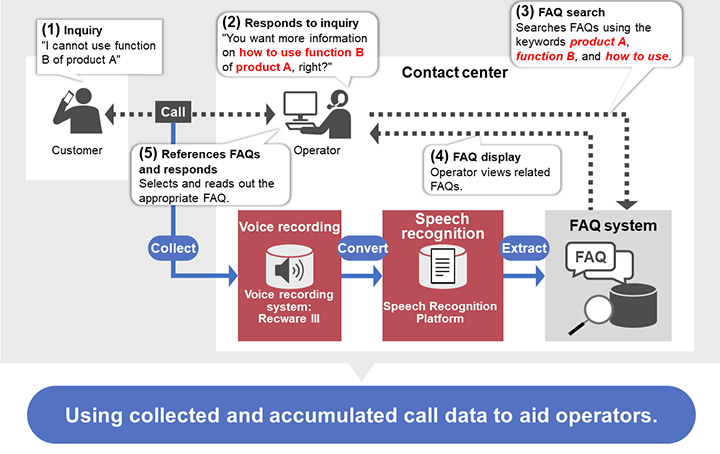
With this solution, the current inquiry call is converted into text format. Using keywords extracted from the current call, the solution searches the FAQ system for FAQs containing those keywords. The system then shows a list of relevant FAQs on the operator’s computer monitor. From the displayed candidates, operators choose and read the response that best matches the nature of the inquiry. Through this process, operators can provide excellent responses regardless of their experience.
This process of using the accumulated data of recorded calls greatly helps operators to check what happened previously.
Using speech data converted to text to analyze customer needs and aid operators
We provide a total support solution for analyzing VOC (voice of the customer) and aiding operators. This solution encompasses all necessary aspects: from consulting on the use of recorded calls, to building and operating the environment required for the customer to record calls, use speech recognition with speech-to-text conversion, and perform analysis.
Advances in IoT technology make it possible to create digital records of various phenomena, human language, and behavior. Coupled with advancements in speech recognition and data analysis technologies, these advances have paved the way for communications with customers to be incorporated into measures addressing a wide range of issues, including aiding contact centers.
The Speech Digital Solution promotes the effective application of recorded calls in business operations by using recorded calls as digital assets, which can enhance contact center operations and aid VOC analysis. For this solution, we provide the following three services.
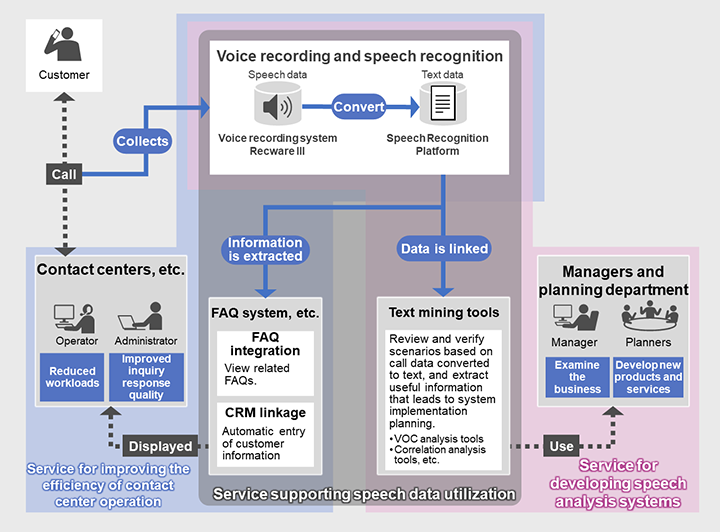
We are working to further enhance the services provided for the Speech Digital Solution to incorporate AI-driven advanced analysis and auto-response services.
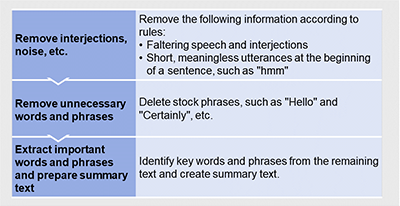
To make full use of speech data that has been transcribed into text, you need to have some way to remove faltering speech such as "uhh" and "umm", interjections such as "ah!", meaningless filler words such as "hmm", and stock phrases such as "Hello" and "Certainly".
Our automatic text summarization system, CoreExplorer/TS, removes phrases unsuitable for analysis (such as faltering speech and superfluous stock phrases) from the text data, and extracts and summarizes only the important parts in the text data.
This form of summarization employs automated machine learning, which reduces the amount of labor required. The system can autonomously determine and summarize key parts of text data by reading work-related data, FAQs, and past inquiries related to the text being summarized. This also reduces the operating costs of the text summarization system.
This section provides examples of how this solution can be used to improve contact center operations, and how call analysis can aid in business development.
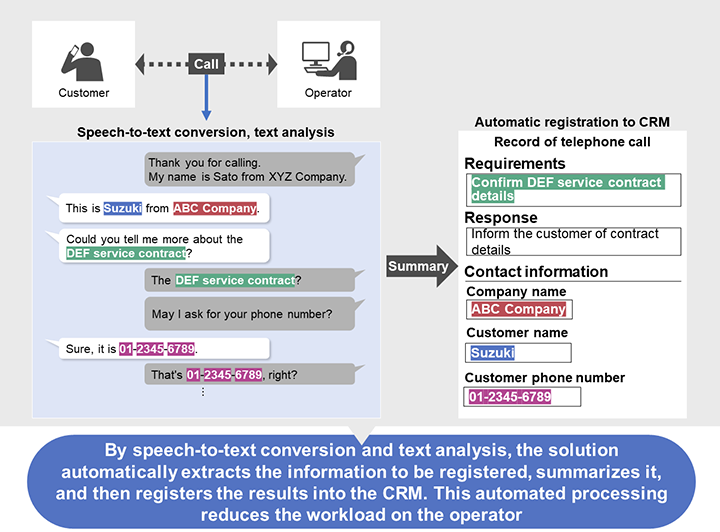
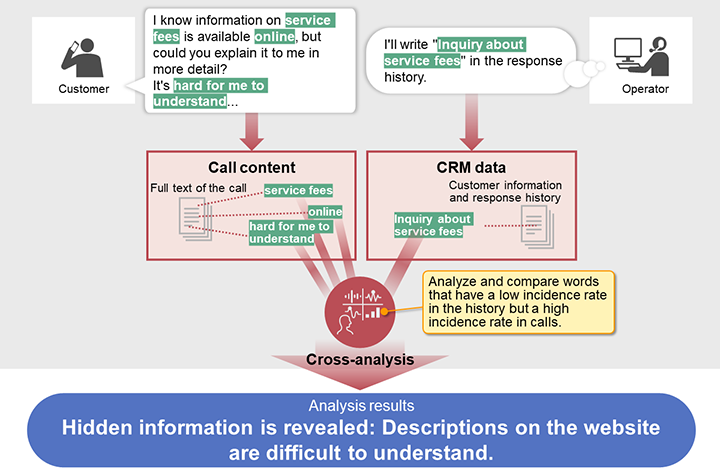
For details on our solutions, see the following webpages.
For details on the related solution, Next Generation Contact Center, see the following webpage.
VOC (voice of the customer) analysis* aids efforts to develop and improve products and services. In VOC analysis, speech recognition is used to transcribe the content of calls into text format (speech-to-text conversion). The system extracts frequently used terms and phrases, which helps company personnel to visualize customer issues and provides hints regarding areas where products can be, or should be, improved. In this way, calls recorded and accumulated at a contact center on a daily basis can be used to generate business ideas.